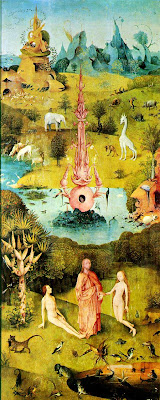Bosch, The Garden of Eden


Toward the center of the panel is the fountain of life in the form of a Gothic monument. The fountain itself is not strictly biblical, but it does fit with the biblical and ancient Near Eastern image of waters of life flowing down to earth from Eden. To the far right of the fountain you can see the Tree of Knowledge, with the serpent coiled around it. The center panel of the tryptich (not shown) depicts the fallen world, and the tree is positioned so as to lead the eyes into that panel.

In the bottom third of the image, God (in the form of Jesus, the creative Word) introduces newly formed Eve to Adam. Behind Adam a fantastic cactus symbolizes the Tree of Life. But even at this tender moment of introduction, there are clear signs that all is not well. Elements at the bottom of the painting, especially the mouse in the cat's mouth, herald the imminent arrival of violence and sin into the world.
Labels: art
0 Comments:
Post a Comment
<< Home